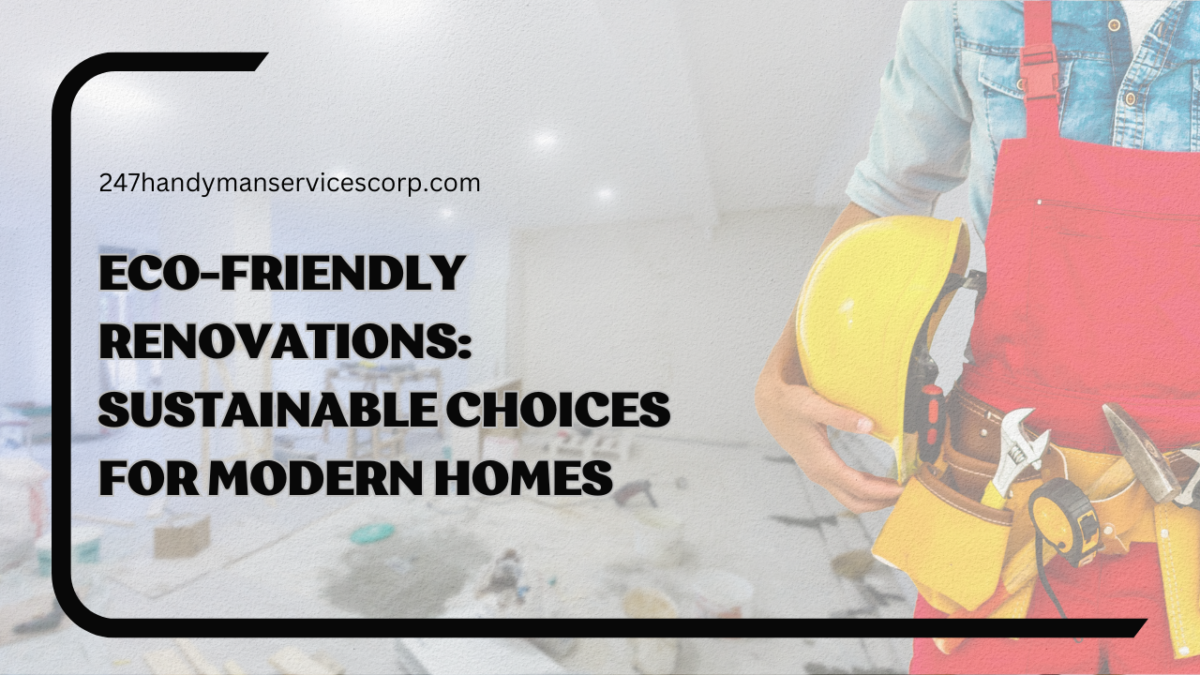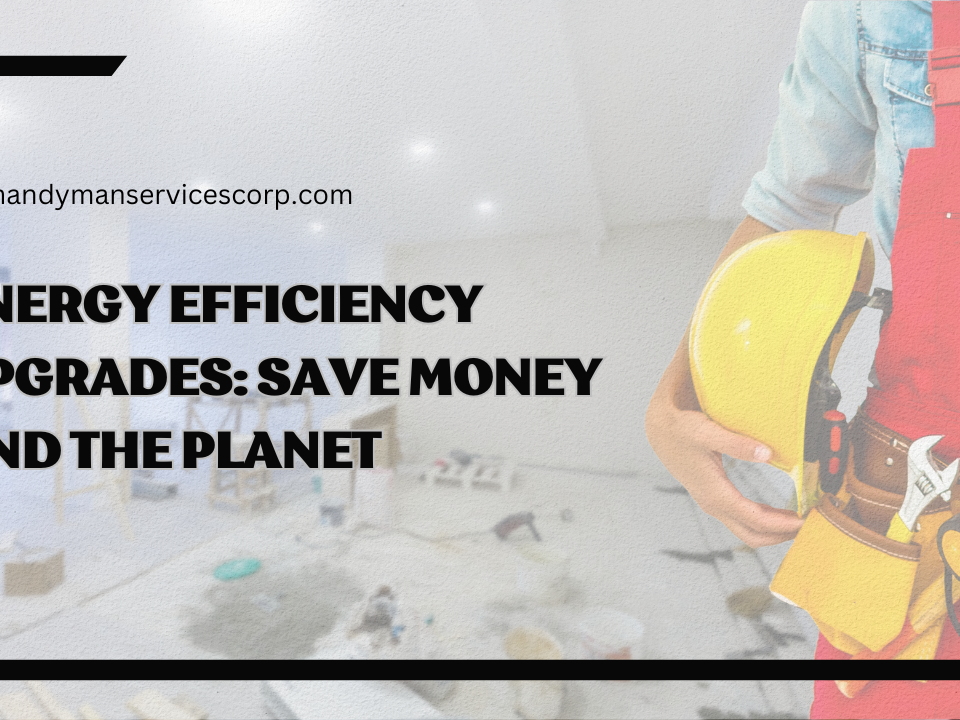Eco-Friendly Renovations: Sustainable Choices for Modern Homes

Energy Efficiency Upgrades: Save Money and the Planet
April 30, 2025
The Importance of Regular Home Maintenance: A Proactive Approach
May 14, 2025Key Takeaways
- Eco-friendly renovations can reduce your home’s carbon footprint while saving you money through reduced energy bills and available tax incentives.
- Sustainable building materials like bamboo, recycled content products, and low-VOC paints improve indoor air quality and reduce environmental impact.
- Energy-efficient upgrades, including proper insulation and modern HVAC systems, can yield thermal energy savings of up to 59%.
- Home renovations with sustainability in mind can increase property value, with green buildings yielding $53-$71 per square foot in returns over 20 years.
- Even small, budget-friendly changes can make a significant environmental impact when approached strategically.
Did you know the residential sector generates approximately 20% of global energy-related greenhouse gas emissions? That’s a sobering statistic that highlights just how significant our homes are in the climate equation. But here’s the good news: every renovation choice you make has the potential to reduce this impact, while simultaneously creating a healthier living environment and potentially increasing your home’s value.
Gone are the days when “eco-friendly” meant compromising on aesthetics or breaking the bank. Today’s sustainable home improvements offer an exciting blend of innovation, style, and practicality—with options for every budget and home type. Whether you’re planning a complete renovation or looking for smaller upgrades with meaningful impact, embracing sustainability in your next home project isn’t just good for the planet—it’s a smart long-term investment.
Understanding Eco-Friendly Renovations: More Than a Trend
What Are Sustainable Home Improvements?
Eco-friendly renovations go far beyond simply using “green” products. True sustainable home improvements consider the entire lifecycle of materials and systems—from extraction and manufacturing to installation, use, and eventual disposal or recycling.
These renovations typically focus on four key areas:
- Energy efficiency: Reducing energy consumption through better insulation, efficient appliances, and smart systems
- Water conservation: Implementing fixtures and systems that minimize water usage
- Sustainable materials: Choosing products with recycled content, renewable sources, and low environmental impact
- Indoor environmental quality: Creating healthier living spaces by reducing toxins and improving air circulation
When these elements work together, the result is a home that treads more lightly on the planet while providing a healthier, more comfortable living environment for its occupants.
Why Sustainability in Home Renovation is Essential
Sustainable renovations aren’t just about feeling good about your environmental choices—they deliver tangible benefits across multiple fronts. A fascinating study in the United Kingdom revealed that even when sustainability wasn’t the primary goal of building refurbishments, the renovated buildings still demonstrated significantly lower operating costs. This points to an important truth: eco-friendly choices often align perfectly with economic ones.
The benefits of sustainable renovations extend to:
- Environmental impact: Reduced resource consumption, lower emissions, and less construction waste
- Economic advantages: Lower utility bills, potential tax incentives, and higher property values
- Health improvements: Better indoor air quality, reduced exposure to toxins, and improved thermal comfort
- Resilience: Better adaptation to climate change and extreme weather events
The growing focus on sustainable building practices isn’t just a passing trend—it’s becoming the new standard in modern home repair and renovation. For more on how sustainable practices fit into broader home improvement trends, check out our article on what are the top trends in modern home repair services.
The Environmental & Economic Impact of Home Upgrades
Reducing Your Carbon Footprint at Home
Your home’s carbon footprint comes from multiple sources—heating and cooling systems, lighting, appliances, water heating, and even the embodied carbon in building materials. Each renovation decision presents an opportunity to reduce these emissions.
What’s particularly encouraging is the scale of improvement possible. Deep energy retrofits—comprehensive approaches to improving a home’s energy performance—can yield energy savings of 30 percent or more, often spread over several years. These improvements not only reduce your home’s environmental impact but can significantly enhance its market value as well.
Consider these high-impact areas for carbon reduction:
- Home envelope improvements: Air sealing, insulation, and upgraded windows/doors
- Efficient mechanical systems: Modern HVAC, heat pumps, and water heating
- Reduced water usage: Low-flow fixtures and smart irrigation
- Renewable energy: Solar panels and battery systems
Did you know? Studies of energy refurbishments in residential buildings have shown average thermal energy savings of 59% during heating seasons—a dramatic improvement that translates directly to lower carbon emissions and reduced utility bills.
The Rising ROI of Green Building
The financial case for eco-friendly renovations continues to strengthen. Green building is no longer just an ethical choice—it’s increasingly a smart economic one.
Research has shown that over a 20-year lifespan, some green buildings have yielded between $53 and $71 per square foot in investment returns. These returns come from multiple sources:
- Reduced operating costs (lower energy and water bills)
- Increased property value (growing market premium for efficient homes)
- Tax incentives and rebates
- Improved durability and reduced maintenance costs
The Inflation Reduction Act, which went into effect on January 1, 2023, has dramatically expanded the financial incentives available for sustainable home improvements. Homeowners can now access tax credits and rebates for energy-efficient upgrades, making eco-friendly choices more affordable than ever.
For a deeper dive into how energy-efficient upgrades can benefit both your wallet and the planet, check out our article on energy efficiency upgrades: save money and the planet.
Choosing Green Building Materials
Eco-Conscious Material Selection
The materials you choose for your renovation have lasting implications for both environmental impact and indoor air quality. Fortunately, the market for sustainable building materials has expanded dramatically in recent years, offering attractive options for virtually any application.
Here’s a breakdown of some top sustainable material choices:
| Material Category | Eco-Friendly Options | Environmental Benefits |
|---|---|---|
| Flooring | Bamboo, cork, reclaimed wood, natural linoleum | Renewable resources, reduced harvesting of old-growth forests |
| Insulation | Recycled denim, cellulose, wool, mineral wool | Often made from recycled content, better indoor air quality than conventional options |
| Countertops | Recycled glass, FSC-certified wood, reclaimed materials | Diverts waste from landfills, reduces virgin material extraction |
| Paint | Low/zero-VOC options | Improves indoor air quality, reduces harmful emissions |
| Lumber | FSC-certified wood, reclaimed timber | Supports responsible forestry, reduces demand for new logging |
When selecting materials, consider these key factors:
- Recycled content: Materials made from recycled elements reduce the need for virgin resource extraction
- Reclaimed materials: Salvaged wood, brick, and other elements add character while eliminating the need for new production
- Locally sourced options: Reduced transportation emissions and support for local economies
- Low-emission products: Materials that don’t off-gas harmful volatile organic compounds (VOCs)
- Durability: Longer-lasting materials mean less frequent replacement and less waste
Sourcing and Certifying Green Products
With the proliferation of “greenwashing”—misleading claims about environmental benefits—it’s important to know how to identify truly sustainable materials. Third-party certifications can provide assurance that products meet specific environmental standards.
Look for these recognized certifications when sourcing materials:
- Energy Star: For energy-efficient appliances and products
- GREENGUARD: Ensures products meet strict chemical emissions limits
- Forest Stewardship Council (FSC): Certifies wood products from responsibly managed forests
- Cradle to Cradle: Evaluates products for material health, recyclability, and manufacturing ethics
- WaterSense: Identifies water-efficient fixtures and appliances
When shopping for sustainable materials, specialized retailers, green building supply stores, and even mainstream home improvement centers now offer eco-friendly options. Online resources like the Building Green product database can help you research specific products before purchasing.
Energy-Efficient Upgrades That Make a Difference
Insulation, Windows, and Envelope Improvements
The “building envelope”—the barrier between your conditioned indoor spaces and the outdoors—is perhaps the most critical element in your home’s energy performance. Improvements here often yield the highest returns in both comfort and energy savings.
Priority envelope improvements include:
- Comprehensive insulation: Ensuring adequate R-values in attics, walls, and floors
- Air sealing: Addressing leaks around windows, doors, electrical outlets, and other penetrations
- Window upgrades: Replacing single-pane windows with double or triple-glazed units with low-e coatings
- Cool roofing: Selecting reflective materials that reduce heat gain in warm climates
The impact of these improvements can be dramatic. As mentioned earlier, studies show that comprehensive energy refurbishments can lead to thermal energy savings of 59% during heating seasons—a remarkable improvement that translates to both lower carbon emissions and reduced utility bills.
Efficient Lighting and Appliances
While envelope improvements typically yield the greatest energy savings, upgrading lighting and appliances can also make a significant difference—often with a lower upfront investment.
Consider these high-impact upgrades:
- LED lighting: Uses up to 75% less energy than incandescent bulbs and lasts 25 times longer
- Energy Star appliances: Refrigerators, washing machines, and dishwashers with this certification use substantially less energy and water
- Smart power strips: Eliminate “phantom” energy use from electronics when not in use
- Water-efficient fixtures: Low-flow showerheads and faucet aerators reduce both water usage and water heating energy
For many homeowners, these relatively simple upgrades provide an accessible entry point to more sustainable living, with modest costs and immediate benefits.
Heating, Cooling & Hot Water: The Sustainable Way
Heating, cooling, and water heating typically account for the largest share of home energy use. Modern, efficient systems can dramatically reduce this consumption while improving comfort.
Key technologies to consider include:
- Heat pumps: Modern electric heat pumps can significantly reduce greenhouse gas emissions compared to fossil-fuel heating systems, while providing both heating and cooling capabilities
- Smart thermostats: Allow for optimized temperature settings that reduce energy use when you’re away or sleeping
- Heat pump water heaters: Use up to 60% less energy than standard electric water heaters
- Ductless mini-split systems: Provide zoned heating and cooling without the energy losses associated with ductwork
- Hydronic radiant floor heating: Delivers efficient, comfortable heat that operates at lower temperatures than conventional forced-air systems
These mechanical system upgrades often require professional installation. For assistance with implementing these energy-efficient solutions, consider reaching out to skilled professionals through our 5 vital benefits of skilled handyman services resource.
Beyond the Basics: Deep Energy Retrofits & Whole-Home Strategies
What is a Deep Energy Retrofit?
For homeowners looking to maximize both environmental benefits and long-term savings, deep energy retrofits offer a comprehensive approach. A deep energy retrofit involves a whole-house transformation that dramatically reduces energy consumption—typically by 30% or more—while improving comfort, indoor air quality, and resilience.
Unlike piecemeal upgrades, a deep retrofit takes a systems approach, recognizing that components of your home work together. This might include:
- Super-insulating the building envelope
- Eliminating thermal bridges that conduct heat through walls and roofs
- Installing high-performance windows and doors
- Implementing mechanical ventilation with heat recovery
- Upgrading to highly efficient HVAC and water heating
- Adding renewable energy systems like solar panels
Though the upfront investment is higher than individual improvements, deep retrofits can significantly improve building value while delivering dramatic energy savings for decades to come.
Financing & Incentive Programs for Major Upgrades
The substantial upfront costs of comprehensive energy retrofits can be a barrier for many homeowners. Fortunately, numerous financing options and incentives can help make these improvements more affordable.
The financial landscape for energy retrofits is increasingly promising. A business case study by The Rockefeller Foundation sized the potential of the retrofitting market in the USA at a $279 billion investment opportunity—an indication of both the scale of the opportunity and the growing availability of financial resources to support it.
Available financial resources may include:
- Federal tax credits: The Inflation Reduction Act expanded and extended tax credits for energy-efficient improvements
- Utility rebates: Many utilities offer cash back for energy-efficient appliances, insulation, and other upgrades
- State and local incentives: Vary by location but may include additional rebates, tax incentives, or low-interest financing
- Energy-efficient mortgages: Allow homeowners to finance energy improvements as part of a home purchase or refinance
- PACE financing: Property Assessed Clean Energy programs that tie repayment to property tax assessments
For the latest information on available programs and incentives in your area, be sure to check our our blog for regular updates.
Small Changes, Big Impact: Quick Upgrades for Every Budget
Low-Cost, High-Impact Sustainable Solutions
Not every eco-friendly improvement requires a major investment. Some of the most impactful changes are also among the most affordable and accessible:
- Weatherstripping and caulking: Sealing air leaks around windows, doors, and other penetrations can reduce heating and cooling costs by up to 20%
- Smart power strips: Eliminate phantom energy use from electronics when not in use
- LED light bulbs: Replace incandescent bulbs with LEDs for immediate energy savings and longer bulb life
- Low-flow aerators and showerheads: Reduce water consumption without sacrificing pressure or performance
- Programmable thermostats: Adjust temperatures automatically for times when you’re away or sleeping
- WaterSense toilets: Replace older models that may use up to 5 gallons per flush with efficient 1.28 gpf models
- Eco-friendly cleaning products: Reduce indoor air pollution and chemical runoff
These smaller improvements may seem modest individually, but collectively they can make a substantial difference in your home’s environmental footprint—while saving you money each month.
Prioritizing Projects for Maximum Benefit
With limited time and budget, it’s important to prioritize your sustainable renovation efforts. Here’s a framework for determining which projects to tackle first:
- Start with an energy audit: Many utilities offer free or discounted home energy assessments that can identify your biggest energy losses
- Address safety issues first: Ensure proper ventilation, address any moisture problems, and test for radon and other hazards
- Target the “low-hanging fruit”: Begin with high-ROI improvements like air sealing, adding insulation to an uninsulated attic, and upgrading to LEDs
- Consider your climate: In cold climates, focus first on heating efficiency; in hot climates, prioritize cooling and solar heat gain reduction
- Plan for the long term: Create a multi-year strategy that aligns with your financial resources and home maintenance schedule
Remember that incremental improvements add up. Even if you can’t do everything at once, each eco-friendly choice moves your home in a more sustainable direction.
Common Barriers & How to Overcome Them
Myths and Real-World Challenges
Despite the compelling benefits of eco-friendly renovations, several common misconceptions and practical challenges can deter homeowners from taking action:
Myth #1: Sustainable renovations always cost more
Reality: While some green options have higher upfront costs, many (like air sealing or LED lighting) are very affordable. Moreover, the long-term savings often make sustainable choices more economical over time.
Myth #2: The benefits aren’t worth the hassle
Reality: Modern eco-friendly products perform as well as or better than conventional alternatives, while delivering energy savings, improved health, and increased home value.
Myth #3: My small changes won’t make a difference
Reality: Collective action drives market transformation. Each sustainable choice not only reduces your environmental footprint but also contributes to broader system change.
Real-world challenge: Phasing renovations with limited budget
Solution: Create a prioritized plan based on energy audit results, tackling the most cost-effective improvements first and planning larger investments over time.
Real-world challenge: Finding qualified contractors
Solution: Look for professionals with specific green building certifications and experience, and ask for references from similar projects.
How to Find Trusted Green Professionals
The success of your eco-friendly renovation depends significantly on the expertise of the professionals you hire. Here’s how to find qualified help:
- Look for relevant credentials: Certifications like LEED Professional, BPI Building Analyst, or NARI Green Certified Professional indicate specialized training
- Check portfolios and references: Ask to see examples of previous sustainable projects and speak with past clients
- Interview multiple professionals: Discuss your sustainability goals and gauge their knowledge and enthusiasm for green building practices
- Get detailed proposals: Ensure estimates include specific eco-friendly materials and practices
- Check local resources: Many communities have green building associations or directories of sustainable contractors
For assistance finding qualified professionals in your area who understand sustainable building practices, explore our resource on near me handyman: discover your area’s best services.
Future-Proofing Your Home: Preparing for Tomorrow
Upcoming Trends in Sustainable Renovation
The field of sustainable home renovation continues to evolve rapidly. Staying aware of emerging trends can help you make forward-looking choices that will serve you well into the future:
- Electrification: The movement toward all-electric homes, eliminating fossil fuels for heating, cooking, and hot water
- Smart home integration: Advanced systems that optimize energy use based on occupancy, weather, and time of day
- Battery storage: Home battery systems that pair with solar panels to increase resilience and enable greater energy independence
- Heat pump technology: Continued advancements in heat pumps for space and water heating that offer greater efficiency and cold-climate performance
- Healthy building materials: Growing emphasis on non-toxic materials that contribute to better indoor air quality
- Water recycling systems: Greywater systems that reuse water from sinks and showers for irrigation
When planning renovations, consider how these trends might influence your choices. Will the systems you install today be compatible with the sustainable home of tomorrow?
Aligning Upgrades with Community & Resale Goals
Your home exists within a broader community context, and sustainable renovations can contribute to neighborhood resilience while enhancing your property’s appeal to future buyers.
Consider these factors when planning eco-friendly improvements:
- Climate resilience: Features like improved insulation, backup power systems, and water conservation measures help homes withstand extreme weather events
- Community aesthetics: Exterior renovations that balance sustainability with neighborhood character
- Market trends: Growing buyer preference for energy-efficient homes with lower operating costs and healthier indoor environments
- Documentation: Keeping records of green upgrades and their performance to demonstrate value to future buyers
By thinking beyond your immediate needs to consider both future market demands and community context, you can make sustainable choices that deliver lasting value.
The Lifelong Value of Eco-Friendly Renovations
As we’ve explored throughout this article, eco-friendly renovations offer a powerful triple benefit: they’re good for the planet, good for your wallet, and good for your quality of life. From simple weekend projects like installing LED bulbs or weatherstripping doors to comprehensive deep energy retrofits, every sustainable choice you make contributes to a better future.
The evidence is clear: homes renovated with sustainability in mind consume less energy, produce fewer emissions, and often command higher resale values. With studies showing energy savings of up to 59% from comprehensive retrofits and green buildings yielding $53-$71 per square foot in returns over 20 years, the economic case is as compelling as the environmental one.
But perhaps most importantly, sustainable renovations create healthier, more comfortable living spaces—homes that better serve the people who inhabit them while treading more lightly on the planet.
Ready to start your sustainable renovation journey? Whether you’re planning a major transformation or looking for simple weekend improvements, our team of knowledgeable professionals can help you identify the most impactful options for your specific home and budget. Contact us today to learn how we can help make your eco-friendly renovation goals a reality.
FAQs
What are the most cost-effective eco-friendly renovations for homeowners on a budget?
The most cost-effective sustainable improvements typically include air sealing (caulking and weatherstripping), upgrading to LED lighting, installing programmable thermostats, adding attic insulation, and installing water-efficient fixtures. These projects generally have payback periods of less than five years while delivering immediate energy savings.
How much can I expect to save on utility bills after completing energy-efficient upgrades?
Savings vary based on your climate, existing home efficiency, and the scope of improvements, but many homeowners see reductions of 20-30% after implementing basic energy efficiency measures. Deep energy retrofits can reduce energy consumption by 50% or more. An energy audit can provide more specific estimates for your home.
Are there any eco-friendly renovations that can increase my home’s value?
Yes! Energy-efficient windows, modern HVAC systems, proper insulation, and sustainable landscaping all tend to increase home value. According to various real estate studies, energy-efficient homes often command premium prices—typically 2-6% higher than comparable conventional homes.
What are the best eco-friendly alternatives to traditional building materials?
Some excellent sustainable alternatives include bamboo or cork flooring instead of hardwood, recycled glass countertops instead of granite, cellulose or wool insulation instead of fiberglass, reclaimed wood for various applications, and low-VOC paints and finishes. The best choice depends on your specific application, climate, and design preferences.
How do I know if a contractor has experience with sustainable building practices?
Look for contractors with green building certifications like LEED AP, BPI Building Analyst, or NARI Green Certified Professional. Ask about their previous experience with sustainable projects, request references from similar jobs, and inquire about their familiarity with eco-friendly materials and energy-efficient construction techniques.




